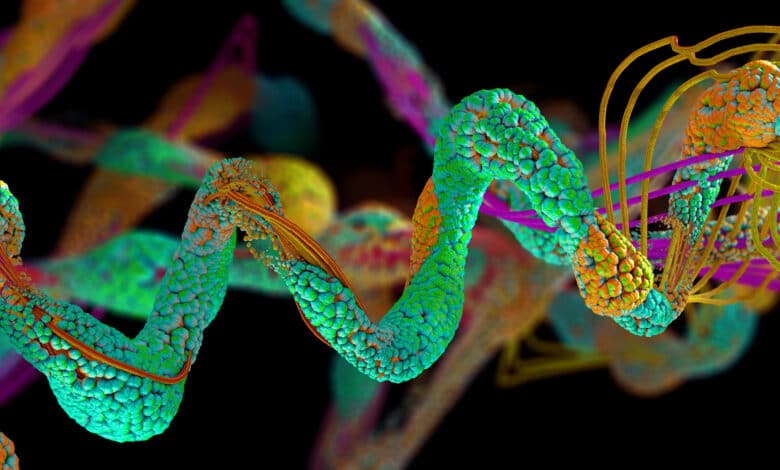
We may be on the verge of the next major breakthrough in storage technologies. Researchers in the U.S., for example, report that synthetically produced DNA can be used to fit a large data set into even a microscopic space.
The next big advance
If you take a look at storage media from ten years ago, it is sometimes startling to see the great strides science has made in that comparatively short time. This does not only apply to the sheer speed of data carriers, which has increased significantly due to the switch from magnetic hard disks (HDD) to flash memory in the form of solid state drives (SSD). The available storage space has also increased significantly. But lately, it feels as if IT researchers have slowly reached the end of the line in the field of SSDs. Now, however, the all-clear has come from the ranks of science, and at the same time hope for a gigantic technological step.
Researchers have finally found a way to store huge amounts of data in a very small space. And the human body plays a model role in this. More precisely, science is taking its cue from our genetic code – DNA. While in humans it stores the most important information about the genetic makeup, in the field of technology it could serve as a perfect data store thanks to its ingenious design. It should not only be able to provide plenty of space. On top of that, researchers promise a reliable storage period of thousands of years. Accordingly, scientists are currently feverishly researching ways to imitate DNA synthetically.
Bases are at the heart of it
Those who can still dimly remember their biology classes may remember that DNA is composed of three different bases. In addition to adenine and guanine, cytosine and thymine are also part of it. The information about the genetic material of every living being is encoded by an almost endless combination of these four bases. US researchers at the University of Illinois Urbana-Champaign have now taken this principle as their model. After a long period of research, the scientists can now announce their first breakthroughs. In addition to the four bases of the natural model, they have succeeded in producing a further seven bases.
This is according to a technical article in the magazine Nano Letters. Since the synthetic DNA produced by the scientists has nearly three times as many bases as the DNA found in nature, there are naturally many more possible combinations. Kasra Tabatabaei briefly outlined the idea behind synthetic DNA and the expansion of bases. He is a member of the U.S. university’s research team. Tabatabaei said:
“Instead of converting zeros and ones into A, G, C, and T, we can convert zeros and ones into A, G, C, T, and the seven new letters of the memory alphabet.”
This is just the beginning
However, the new way to store data developed by the U.S. researchers will be a long time coming. So far, in fact, with the replica of DNA, only the basic construct is in place. In addition to the storage concept itself, it is also important that the stored data can be read out at all. The reason for this is that the DNA method is a completely new principle. There is currently no system that can handle the stored data. But the researchers already have a suitable solution for this as well. The focus here is on the exciting “Deep Learning” method. In combination with special sequencing using nanopores, this should make it possible to read out the data. The scientists are therefore relying on the possibilities that artificial intelligence reveals to them. They state in this regard:
“We tried 77 different combinations of the 11 nucleotides, and our method was able to perfectly distinguish each of them […] The deep-learning framework is universal as part of our method for identifying different nucleotides, which allows the generalization of our approach to many other applications”
More memory density and less latency
The method may sound groundbreaking and exceedingly exciting. But the end result should be enjoyed not only by the scientific community, but also by end users. After all, the use of synthetic DNA offers various advantages for the storage medium. For one thing, there is the storage density. If the scientists’ statements are to be believed, we can probably expect a doubling here. That would be really impressive. But not only more data should be able to be stored on a storage medium. On top of that, the latency is supposed to be much lower. The following emerges from the Nano Letters article in this regard:
“Overall, the expanded molecular alphabet can potentially offer a nearly twofold increase in storage density and possibly a reduction in recording latency of the same order of magnitude, enabling new implementations of molecular recording devices.”
There are still some construction sites
So far, it all sounds consistently like a breakthrough in memory technology. But scientists are obviously still in the early stages of their thinking. In the area of data infrastructure in particular, in fact, they still have a few construction sites that need to be addressed. Put simply, there is currently still a lack of suitable storage media on which the DNA-based technology can be accommodated. Both reading out and simply storing the data still pose a major challenge for researchers. Incidentally, the Fraunhofer Institute, inventor of the MP3 file among other things, has also commented on the subject:
“Compared with conventional storage media, the process steps are complex and expensive, difficult to automate and difficult to integrate into practicably usable mobile systems. For this reason, they are particularly suitable for stationary archiving of large volumes of data over long periods of time. From a technical point of view, they should already be practicably usable here in the medium term.”
Future smaller server farms?
The fact that corresponding storage media could probably only be made mobile in an overly complicated way is unlikely to bother at the beginning. After all, the special DNA technology offers in particular the possibility of making server farms much smaller than is the case now. Here, one can take a look at an example that the colleagues from Golem have produced. With the help of the new storage technology, the data of the entire Internet could theoretically be stored in just one small shoebox. However, one downer is likely to stand in the way of this dream – the transmission rate.
In 2019, the startup CATALOG already tried its hand at the DNA method. The employees of the small company took on the task of storing Wikipedia’s database on DNA. At that time, the data of the English edition of the online encyclopedia comprised 16 GB. When they wanted to store it on the manufactured DNA memory, they noticed the poor transfer rate. This was just about 0.5 MB/s. So here, too, the U.S. researchers absolutely have to find a suitable solution. In any case, we are curious to know whether they are currently working on the storage media of the future and will keep you up to date on this.



